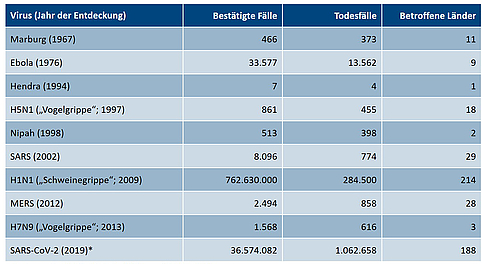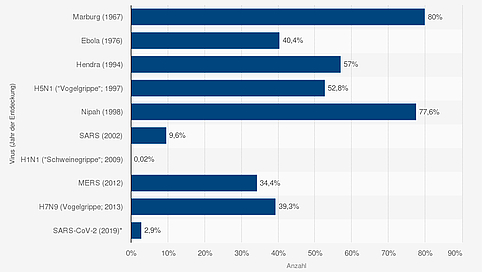Topic in Focus
How are Global Outbreaks Managed?

Image: Adobe Stock / angellodeco
Pandemics require information exchange and coordinated action at an international level. In this respect, the World Health Organization (WHO) assumes a central role. In 1999, the WHO called on each country to develop national pandemic plans. In Germany, the Robert Koch Institute (RKI) has developed such an emergency plan. To contain a pandemic, the expertise of scientists from various research disciplines is needed. These challenges can only be mastered in an interdisciplinary fashion.
When is a pandemic declared?
The World Health Organization (WHO) decides whether an occurrence of a disease is considered a pandemic. It monitors the occurrence of diseases and infections worldwide. Each country must also inform the WHO of any outbreaks of disease. The International Health Regulations (IHR), which are binding for all states under international law, are the basis. These regulations contain an evaluation scheme for classifying an outbreak of a disease in any country. If the assessment indicates that the disease could spread internationally, the country must notify the WHO within 24 hours.
Case numbers and fatalities of selected virus outbreaks worldwide until 2020. *As of October 9, 2020. Sources: CDC; United Nations; WHO; NEJM; Lancet; Johns Hopkins University; Thomson Reuters | Statista 2020
Following notification, the WHO convokes an emergency committee. This committee decides on measures to contain the disease and prevent its spread. If this fails and the disease spreads across countries and continents, the committee classifies the event as a pandemic and declares a “public health emergency of international concern”.
Considering the thousands of cases of infection reported to the WHO since the International Health Regulations came into force in 2005, it has rarely been necessary to convene an emergency committee. As of 2020, only six public health emergencies of international concern have been declared. These six cases were: influenza A virus in 2009, human poliovirus in 2014, Ebola virus in 2014 and 2019, Zika virus in 2016 and SARS-CoV-2 in 2020.
Case fatality rate of selected virus outbreaks worldwide until 2020. *As of October 9, 2020. Sources: CDC; United Nations; WHO; NEJM; Lancet; Johns Hopkins University; Thomson Reuters | Statista 2020
The tasks of the national institutions – informing and coordinating
Each country has a center designated for communication with the WHO, a national IHR focal point. In Germany, this is the German Joint Information and Situation Centre (GMLZ). The GMLZ is under the authority of the Federal Ministry of the Interior (BMI). The Robert Koch Institute (RKI) coordinates all measures and reports in the country. The core task of the RKI is the prevention of communicable diseases, the early detection of infections, and the prevention of their further spread. The institute advises the Federal Ministry of Health (BMG), informs the public, and collates data from local health authorities.
If a pandemic has been declared, the Infection Protection Act is the basis for all further measures. It is applied, for example, to infectious diseases such as measles, cholera, Ebola, or COVID-19. The law allows the federal states to restrict various constitutional rights to prevent the spread of a virus. However, these restrictions must be proportionate. Constitutional rights such as freedom of movement, freedom of assembly, or right of personality may also be restricted.
“A pandemic or epidemic is a general health hazard in which the general public, and this is the essential part of protection, must be safeguarded from ill or infected people. This is precisely where the boundary lies: Where do personal rights end, and where do general rights begin, including the personal right to be protected from infected individuals? We have discussed this to the last detail in the AIDS debate. Is a doctor allowed to warn the wife of an AIDS-infected person, for example? In other words, the doctor is breaking the rule of confidentiality by warning the wife. So this has already been discussed in detail and the argument will always be there. In short, a public defense against massive epidemics is not possible without limiting personal rights.”
The tasks of research – developing therapies, protecting people
The Friedrich-Loeffler-Institut (FLI) is the Federal Research Institute for Animal Health. It has its headquarters on the island of Riems. Among other things, the FLI's mission is to protect humans from zoonoses. Scientists conduct research on zoonotic pathogens in high-security laboratories. For example, the infectivity of the novel virus SARS-CoV-2 in different animal species was tested here. This provides information on whether farm animals such as pigs, chickens, or cattle could play a role in spreading a virus or whether certain animal species are particularly suitable as animal models. Animal models are used to study disease progression and to test active ingredients for vaccines and drugs. In addition, researchers want to understand how pathogens are transmitted from animals to humans.
“Well, ferrets are considered to be a very good model for respiratory infections, i.e. respiratory diseases in humans. Ferrets are used especially in influenza virus research for this purpose, but also in terms of transmission from animal to animal. What we are researching here are different aspects. For one thing, they are well suited for testing vaccines. In other words, what effect does a vaccine have on the reproduction of the virus or the pathogen in the animal, on the excretions, and the transmission? The second aspect is the testing of possible therapeutic substances. This means, are there substances that can suppress the reproduction of the pathogen? But some fundamental aspects are also of interest to us. What actually happens in the interaction between germ and host? How does the host react to an infection or how do the pathogens exactly circumvent the immune response of the host? In animal models, we have the advantage that not only the actual infections are tested, but also, especially considering vaccines, the protection. Because then we can trigger stress infections, as we call them, experimentally, and then see whether the protection against the infection really exists and how far it extends.”
Another important research institution is the Bernhard Nocht Institute for Tropical Medicine (BNITM) in Hamburg. It is Germany's largest facility for research on tropical and new infectious diseases. One focus of the institute is research on malaria and the transmission of viruses by mosquitoes.
To better understand zoonoses and pathogen transmission pathways, human and veterinary medicine must work hand in hand and share their specific knowledge. This is why Germany has established the National Research Platform for Zoonoses. Scientists working in the field of zoonoses research meet on this information and service network. They exchange information on aspects such as characterization of pathogens, development of infection models, diagnostics and prevention of zoonoses, vaccine development, and early warning systems.
Published: November 2020
Previous Page: Emergence of Pandemics
Next Page: How are Infectious Diseases Investigated and Treated?




